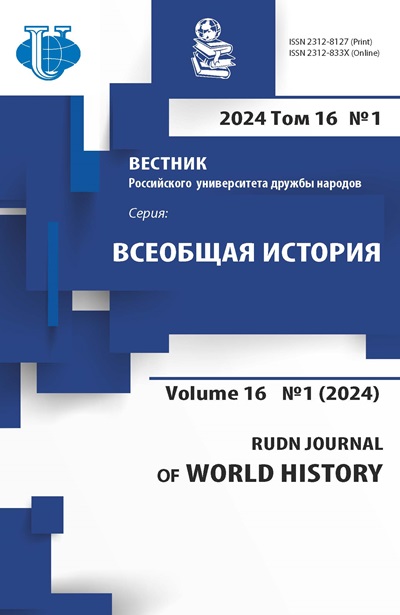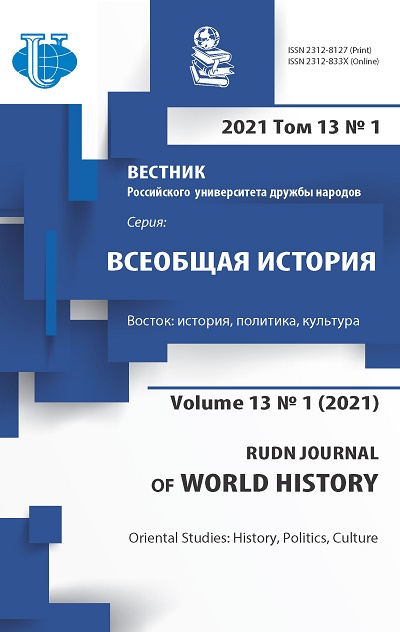Ainu in modern Japanese society: the problem of returning the remains of ancestors
- Authors: Chekunkova E.S.1
-
Affiliations:
- Ural Federal University named after the First President of Russia B.N. Yeltsin
- Issue: Vol 13, No 1 (2021): Oriental Studies: History, Politics, Culture
- Pages: 96-113
- Section: History of culture
- URL: https://journals.rudn.ru/world-history/article/view/25728
- DOI: https://doi.org/10.22363/2312-8127-2021-13-1-96-113
Cite item
Full Text
Abstract
The article is devoted to the issue of repatriation of Ainu ancestral remains, collected by Japanese researchers in the second half of the 19th - 20th centuries. It is the most crucial current issue for many Ainu people who are trying to regain the language, the distinct culture, and identity. The article analyzes the positions of the Japanese Government, the Hokkaido Ainu Association and Ainu rights activist groups and movements. The article examines the contradictions that arose in Japanese society concerning the process of repatriation. Discussions in Japanese society during this problem were analyzed, and its significance for the Ainu communities is revealed. It was found that the discussions mainly arise in connection with the idea of transferring the remains to the memorial hall located in Symbolic Spaces for Ethnic Harmony, which was opened in July 2020. Research also showed that the problem under study is largely related to limitations in ethnic policy implementation and realization of indigenous peoples’ rights in Japan. In addition, the process of repatriation of Ainu ancestral remains is compounded by the lack of unity of the Ainu as a community. Therefore, reaching agreement between the government, the academic community, and critical Ainu rights activist groups proved extremely difficult. However, it was concluded that there is a potential to resolve the issue and consensus could be reached in the near future.
Keywords
About the authors
Ekaterina S. Chekunkova
Ural Federal University named after the First President of Russia B.N. Yeltsin
Author for correspondence.
Email: e_chekunkova@mail.ru
lecturer, postgraduate student
19 Mira str., Yekaterinburg, 620002, RussiaReferences
- Ainu Policy Promotion Headquarters. Cabinet Secretariat. Available from: https://www.kantei.go.jp/jp/singi/ainusuishin/index_e.html [Accessed: 20.10.2020].
- Ken’ichi Ochiai, Teruki Tsunemo. On Policy Measures for the Socio-Economic Betterment of the Ainu People. Hokkaido University Collection of Scholarly and Academic Papers: HUSCAP. July 31, 2013. Available from: https://eprints.lib.hokudai.ac.jp/ dspace/bitstream/2115/52997/1/HLR64-2_009.pdf [Accessed: 12.09.2020].
- A Report on 2011 JDS Fieldtrip in Hokkaido. Master’s Program in Environmental Sciences Graduate School of Life and Environmental Sciences University of Tsukuba. June 26-28, 2011. Available from: http://www.envr.tsukuba.ac.jp/~envethic/pdf/Hokkaido_Report_2011.pdf [Accessed: 12.09.2020].
- Nakamura Naohiro. Redressing injustice of the past: the repatriation of Ainu human remains. Japan Forum. 2018; 31(3):358–377.
- Morris Low. Physical Anthropology in Japan. The Ainu and the Search for the Origins of the Japanese. Current Anthropology, Vol. 53, No. S5; The Biological Anthropology of Living Human Populations: World Histories, National Styles, and International Networks (April 2012). P. 57–68.
- Panel discussion 2: Kunihiko Yoshida. Report on the return home of ritual objects and remains of the deceased in accordance with the UN Declaration on the Rights of Indigenous Peoples. United Nations: website. Available from: https://www.ohchr.org/ RU/Issues/IPeoples/EMRIP/Pages/CallforSubmissionsRepatriation.aspx [Accessed: 09.29.2020].
- Daigakunado ni okeru Ainu no hitobito no ikotsu no hokan jōkyō no sai chōsa kekka. Ministry of Education, Culture, Sports, Science and Technology. Available from: https://www.mext.go.jp/component/a_menu/science/detail/__icsFiles/ afieldfile/2017/05/25/1376459_3_2_1.pdf [Accessed: 04.09.2020]. (In Japanese).
- Hongaku ga hokan suru Ainu ikotsu ni kansuru seimei ni tsuite [Statement regarding Ainu remains kept by the University]. University of Hokkaido. Available from: https://www.hokudai.ac.jp/pr/johokokai/ainu/post-33.html [Accessed: 04.10.2020]. (In Japanese).
- Nakamura Naohiro. Cultural affiliation is not enough: the repatriation of Ainu human remains. Polar Record. 2017; 53(2):220–224.
- Kamuynomi, Icharpa Ceremony for the 12 Repatriated Ainu Ancestral Remains. In Kotan no kai. Available from: https://kotankai.jimdofree.com [Accessed: 23.09.2020].
- Ainu fight for return of plundered ancestral remains. The Japan Times. Aug 12, 2013. Available from: https://www.japantimes.co.jp/community/2013/08/12/issues/ainu-fight-for-return-of-plundered-ancestral-remains/ [Accessed: 14.10.2020].
- Japan’s indigenous Ainu sue to bring their ancestors’ bones back home. The Japan Times. Jul 25, 2018. Available from: https://www.japantimes.co.jp/news/2018/07/ 25/national/japans-indigenous-ainu-sue-bring-ancestors-bones-back-home/ [Accessed 09.10.2020].
- Yuji Shimizu. Towards a Respectful Repatriation of Stolen Ainu Ancestral Remains. URL: https://www.jstor.org/stable/pdf/j.ctv9hj9pb.23.pdf?refreqid=excelsior% 3Aa594324ce3f71b03fa0d7b5c0d8d5292 [Accessed: 01.10.2020].
- Hokkaido Ainu association sues University of Tokyo to have remains returned. The Japan Times. Nov 3, 2019. Available from: https://www.japantimes.co.jp/?post_type= news&p=2287661 [Accessed: 04.10.2020].
- In a Historic First, Australia Agrees to Return Ainu Remains to Japan. Hyperallergic. June 15, 2017. Available from: https://hyperallergic.com/385665/ainu-remains-return-from-australia/#:~:text=The%20bones%20were%20exported%20to,Hokkaido%2C% 20Sakhalin%2C%20and%20Kuril. [Accessed: 03.10.2020].
- Germany Japan bones. AP Archive. July 31, 2017. Available from: http://www.aparchive.com/metadata/youtube/7d3fae63f4bcca7e273a2632c0b261b9 [Accessed: 12.10.2020].
- Germany returns bones of Hokkaido Ainu tribe member to Japan. Screenocean. July 31, 2017. Available from: https://reuters.screenocean.com/record/904754 [Accessed 18.10.2020].
- Minzoku kyousei shouchoukuukann (shouchoukuukann) [National Symbiosis Symbolic Space (Symbol Space)]. Cabinet Secretariat. Available from: https://www.kantei.go.jp/jp/si ngi/ainusuishin/symbolic_space.html [Accessed: 09.10.2020]. (In Japanese).
- Reply of the Government of Japan to the Request for Information from the Expert Mechanism on the Rights of Indigenous Peoples. OHCHR. Available from: https://www.ohchr.org/Documents/Issues/IPeoples/EMRIP/Reportrepatriation/submissions-states/Japan.pdf [Accessed: 10.10.2020].
- Ainu minzoku no ikotsu 1-tai, Tōdai ga Mitsuishi Ainu kyōkai ni henkan inori no gishiki de nōkotsu [One Ainu remains, the University of Tokyo returns to the Mitsuishi Ainu Association]. Hokkaido Simbun. 05.10.2020. Available from: https://www.hokkaido-np.co.jp/article/467176 [Accessed: 16.10.2020]. (In Japanese).
- Daigaku no hokan suru Ainu ikotsu-tō no shutsudo chiiki e no henkan tetsudzuki ni kansuru gaidorain [Guidelines for returning Ainu remains, etc. kept by the university to the excavated area]. Cabinet Secretariat. Available from: https://www.kantei.go.jp/ jp/singi/ainusuishin/pdf/181226_chiiki-guidelines.pdf [Accessed: 06.10.2020]. (In Japanese).
- Morris-Suzuki Tessa. Performing Ethnic Harmony: The Japanese Government’s Plans for a New Ainu Law. The Asia-Pacific Journal: Japan Focus. 16(2), Iss. 21. November 1, 2018 Available from: https://apjjf.org/2018/21/Morris-Suzuki.html [Accessed 12.10.2020].
- Hiroshi Maruyama. Joint Submission to the 13th session of the UN Expert Mechanism on the Rights of Indigenous Peoples at the Palais des Nations in Geneva, Switzerland, from 8 to 12 June 2020. OHCHR. April 13, 2020. Available from: https://www.ohchr.org/Documents/Issues/IPeoples/EMRIP/Reportrepatriation/submissions-indigenous-peoples-ngos/ CEMIPOS.pdf [Accessed 20.10.2020].
- Dollin Ashleigh. Indigenous Peoples’use of media as a form of self-representation: analysis of Japanese government and Ainu discourses relating to the issue of Ainu ancestral remains repatriation. Hokkaido University Collection of Scholarly and Academic Papers: HUSCAP. March 31, 2020. Available from: https://eprints.lib.hokudai.ac.jp/dspace/bitstream/2115/77223/1/7.pdf [Accessed 18.10.2020].
- Richard M. Siddle. Race, Resistance and the Ainu of Japan. – London: Routledge. 2012.
- Oda Hiroshi. Odyssey of an Ainu-skull: From Bone to Human Being. Oct. 15, 2017. Available from: http://skyandocean.sakura.ne.jp/Berlin_conference_15.10.2017.pdf [Accessed 13.10.2020].
- Interview with the researcher of The Hokkaido University Center for Ainu and Indigenous Studies Itsuji Tangiku on 11/26/2018. Personal. arch. the author.
- Human genome diversity research and indigenous peoples. United Nations: Digital Library. Geneva, June 4, 1998. Available from: https://digitallibrary.un.org/record/255830 [Accessed: 19/10/2020]. (In Russ.).
- The United Nations Declaration on the Rights of Indigenous Peoples (UNDRIP). United Nations: website. Available from: https://www.un.org/ru/documents/decl_conv/declarations/indigenous_rights.shtml [Accessed: 19.10.2020]. (In Russ.).
- Higashimura Takeshi. Why do we need new legislation recognizing the Ainu, or the prospects for Japanese policy towards indigenous peoples? Nippon.com: Internet ed. 2019.25 April. Available from: https://www.nippon.com/ru/in-depth/d00479/ [Accessed: 15.10.2020]. (In Russ.)
- Rosaldo Rosaldo. Culture and Truth: The Remaking of Social analysis. Boston, Mass.: Beacon Press, 1993. Available from: https://people.uwec.edu/degravjr/GEOG-ANTH%20351/Rosaldo-CultureAndTruth.pdf [Accessed 24.10.2020].
- Tsagelnik Tatsiana. Discourse of Silencing in the Context of the 150th Anniversary of the Naming of Hokkaido: Representation of AinuWajin Relations in the Television Drama “Eternal Nispa, the Man Who Named Hokkaido, Matsuura Takeshiro”. In: Hokkaido University Collection of Scholarly and Academic Papers: HUSCAP. March 31, 2020. Available from: https://eprints.lib.hokudai.ac.jp/dspace/bitstream/2115/77222/1/8.pdf [Accessed 24.10.2020].
- Upopoi de naze irei? [Why memorial service at Upopoi?]. NHK. 25.10.2020. Available from: https://www.nhk.or.jp/hokkaido/articles/slug-n65d9504da98d [Accessed: 26.10.2020]. (In Japanese).
- Kato Hirofumi. The Ainu and Japanese Archaeology: A change of perspective. Japanese Journal of Archaeology. 2017. Available from: http://www.jjarchaeology.jp/contents/pdf/vol004/4-2_185.pdf [Accessed 23.10.2020].
- Korekara no Ainu jinkotsu fukusōhin ni kakaru chōsa kenkyū no arikata Ni kansuru raundotēburu (gaiyō) [Round table on the future of research on Ainu people and grave goods (review)]. Cabinet Secretariat. Available from: http://www.kantei.go.jp/jp/ singi/ainusuishin/dai8/sankou5.pdf [Accessed: 24.10.2020]. (In Japanese).
- Gulliford Andrew. Bones of Contention: The Repatriation of Native American Human Remains. The Public Historian. 1996; 18(4), Autumn. Available from: https://www.jstor.org/stable/3379790 [Accessed 21.09.2020].
- Outline of the Association. The Ainu Association of Hokkaido. Available from: https://www.ainu-assn.or.jp/english/outline.html [Accessed 23.09.2020].
- Is Japan Closer to Recognizing Indigenous Ainu Rights? The Diplomat. February 13, 2019. Available from: https://thediplomat.com/2019/02/is-japan-closer-to-recognizing-indigenous-ainu-rights/?fbclid=IwAR11XZzsiVAufV-MGJv4vPqo_2QWVxxkIY 4hnC5aJ5W73ru6oVtCa9FP4Vk [Accessed 23.09.2020].













